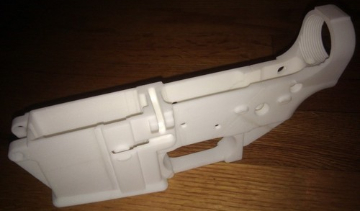
Stratasys says no to 3D printable gun
Mike McLeod
Additive Manufacturing CAD/CAM/CAE Additive Manufacturing CAD Defense Distributed StratasysTexas group loses leased uPrint over effort to create rapid manufactured weaponry.
 Magazine New Scientist reported this week that legal counsel for Stratasys informed the universal gun ownership advocacy group, Defense Distributed, that the company was cancelling the lease of a uPrint SE 3D. Stratasys sited concerns over the group’s Wiki Weapon project, an initiative to design and distribute the CAD data for a 3D printable plastic handgun. At issue is that the group doesn’t have a federal firearms manufacturer’s license.
Magazine New Scientist reported this week that legal counsel for Stratasys informed the universal gun ownership advocacy group, Defense Distributed, that the company was cancelling the lease of a uPrint SE 3D. Stratasys sited concerns over the group’s Wiki Weapon project, an initiative to design and distribute the CAD data for a 3D printable plastic handgun. At issue is that the group doesn’t have a federal firearms manufacturer’s license.
“You have also made it clear that you do not have a federal firearms manufacturers license. Based upon you lack of a license and your public statements regarding your intentions in using our printer, Stratasys disagrees with your opinion,” Legal counsel for Stratasys wrote to the group’s leader, University of Texas law student Cody Wilson. “It is the policy of Stratasys not to knowingly allow its printers to be used for illegal purposes.”
Until recently, Defense Distribued used the Stratasys printer to develop two handgun designs, referred to as Wiki Weapons A & B. According to its website, version A will have no moving parts and use an electrical solenoid for firing, while version B will have moving parts.
 The group’s website also links to the CAD design file, posted on ThingVerse, for what’s called the lower receiver of an .22 caliber AR-15 assault weapon — the semi-automatic version of the M16 — which is legal for public ownership in the U.S. As the base component of the weapon, the lower receiver is the only regulated part (i.e. requiring a weapon manufacturing license).
The group’s website also links to the CAD design file, posted on ThingVerse, for what’s called the lower receiver of an .22 caliber AR-15 assault weapon — the semi-automatic version of the M16 — which is legal for public ownership in the U.S. As the base component of the weapon, the lower receiver is the only regulated part (i.e. requiring a weapon manufacturing license).
However, the ability to produce this component, simply and relatively cheaply, would help facilitate anyone — including those outside the U.S. and those legally barred from gun ownership — to purchase the unregulated metal components and assemble a working AR-15 without any regulatory difficulties. There are no U.S. laws barring citizens from manufacturing weapons for private ownership, but fashioning a lower receiver out of metal would require significantly more skill and effort than 3D printing a ready-made and tested CAD design.
Reportedly, the plastic AR-15 lower receiver has been successfully test fired in an assembled weapon, but Wiki Weapons A & B are still purely in the design phase. Whether ABS Plus, the build material common to Stratasys printers, could stand up to the temperatures and pressures generated in a gun barrel is questionable, Defense Distributed says it will continue with its efforts. The group intends to eventually modify their gun designs to work on the RepRap and other low-entry price DIY printers.
www.stratasys.com
http://defensedistributed.com
